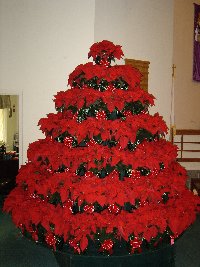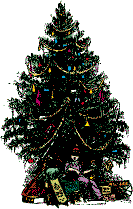|
Page 1:
You can find this and several other MIDI's for "The Holly and the Ivy" at Jacks Shack(link currently broken) |
![]()
The Poinsettia was named for Joel Robert Poinsett, a native of South Carolina. Poinsett was serving as an ambassador in Mexico when he came across the Poinsettia. In 1829 he sent some home from Mexico to South Carolina, where they did very well in his greenhouse.
According to legend, the origin of the poinsettia was as follows: A poor Mexican girl and her brother were on their way to church on Christmas eve but had nothing to give the Christ child. They gathered weeds and made them into a small bouquet. The other children made fun of their gift. When they laid the branches at the manger in the church the weeds were miraculously transformed into bright red and white leaves that we know was the poinsettia.
Another version of the legend speaks of a poor child who prayed for a gift to present to the Christ child. As he knelt at the altar his prayers bright red and green plants grew up at his feet.
There is another completely unrelated legend which says that as the Star of Bethlehem shone of the earth the earth responded by producing a plant that mirrored the star's beauty. The flower was star shaped with white petals and a golden star center. On the day that Christ died on the cross the white petals turned red to remember Jesus blood and some remained white to remember the purity of his sacrifice.
The general shape of the plant and the arrangement of leaves is seen as a symbol of the Star of Bethlehem which led the wise men to the baby Jesus. The red colored leaves symbolize the blood of Christ. The white leaves represent his purity.

Poinsettia Tree at Grace UMC - 2000
![]()
Christian tradition assigns significance to Holly. According to tradition the pointy leaves represent the thorns of Christ's Crown. The perennial green leaves represent eternal life. The red berries represent the blood shed for our salvation.
There is even a tradition that holly was used to make the crown of thorns. At that time the berries were yellow. In honor to the blood shed by Christ the berries turned red.
While holly is most often pictured as having red berries, the berries come in other colors too. One tradition say that white berries represent Jesus purity, green berries the cross of wood, and black berries his death.
![]()
A poor boy had no gift to give the Holy Child, so he made a tiny crown of leaves from a Holly Bush.
Compared to the expensive gifts that the others had given, the crown seeded of little value, so the little shepherd boy began to cry as he presented it. But when the Babe touched the Holly crown with His tiny hand, the leaves suddenly gleamed and the teardrops turned to scarlet berries.
Through the centuries the Holly wreath became a traditional Christmas decoration, reminding us of the Miracle of Christ's Birth.
![]()
Humility is the main idea behind the legends about rosemary.
Every Nativity set I have ever seen pictures Mary wearing blue. According to one legend Mary's blue cloak is where rosemary got it's color. The flowers are said to have been white. Then as Mary, Joseph and the baby Jesus were fleeing to Egypt, Mary laid her cloak on a rosemary bush. Since that time rosemary has been blue.
Another legend says that Mary washed Jesus clothes in a stream while fleeing to Egypt and she laid them on a rosemary bush to let them dry. In honor for the humble service they gave the Savior rosemary were made blue. It is also said that the humble rosemary will never grow higher than Jesus and that if it outlives Jesus' 33 years it will not grow up but out.
![]()
Like the legend of the poinsettia the legend associated with the Christmas rose begins with a poor girl wanting to give a gift to the Christ child.
When Jesus was born in the little town of Bethlehem, there came Wise Men from the East bearing gifts of gold, frankincense, and myrrh.
A little shepherdess, watching from afar, wept because she had no gift to offer the Christ Child. Where her tears fell to the ground there instantly sprang up flowers. She hastened to gather them and bring them to the infant. In adoration she knelt at the crib, so Jesus could see the flowers. When and where His blessed little hands touched the petals, a delicate pink appeared. So a flower that never bloomed before came into existence.. .The Christmas Rose.
To this day, the Christmas Rose blooms more abundantly at Christmas time than at any other season.
![]()
Like the evergreens, ivy is also seen as a symbol of eternal life and is used in Christmas decorations but not to the extent of pine, fir, mistletoe and holly.
![]()
According to legend evergreen trees were not always green. Before the birth of Christ they lost their leaves each winter like other trees. But while Mary, Joseph and Jesus were on their way to Egypt they were forced to hide from Herod's soldiers in a clump of cedar trees. To hide the holy family the trees brought forth green needles and the cedars white berries turned blue so that Mary's blue robe blended in. Since that day evergreen trees have kept their color all year round. Another related legend says that a pine tree hid the holy family and that the baby Jesus left the imprint of his hand forever in their fruit and that if you cut a pine cone lengthwise you can still see the imprint of that tiny hand.
While the legend of the origins of the Christmas tree is interesting the history is equally fascinating. It is known that back long before Jesus Germanic peoples would adorn evergreen trees in winter solstice ceremonies of sorts. The origins of the Christian Christmas Tree can be traced to St. Boniface(8th century) who as a missionary to the Germanic tribes used the triangular shape of evergreen trees as a symbol of the trinity. A legend attached to this origin says that St. Boniface came upon some people preparing to sacrifice a child to an oak tree. In an attempt to stop the sacrifice he grabbed the ceremonial ax and in one blow cut down the oak tree, when it fell a small fir tree sprang from its stump. This legend is probably a way of chronicling in story form that St. Boniface replaced the worship of the Germanic gods, symbolized by the old oak tree with the new Christian religion, symbolized by the Christianized fir tree.
By the 11th century evergreen trees were decorated with apples and bread to symbolize the Tree of Life and the Tree of the Knowledge of Good and Evil told about in Genesis. It was referred to as the Paradise tree and used in religious plays. The Paradise tree became a popular decoration in homes and churches.
There is also the oft repeated story that Martin Luther in the 16th century originated the use of Christmas trees. It is said that one his way home from a Christmas eve service he saw the starlight glistening off the icicles on an evergreen tree. It so reminded him of Jesus the light of the world that he cut the small tree down and took it inside and decorated it with candles to illustrate what he saw.
The tradition of the Christmas tree appears to have been exported to England through royalty from Germany and later to America by German and English immigrants.
More recently the secular Christmas Tree had been further Christianized by the invention of the Chrismon tree.
![]()
In winter, trees lose their leaves revealing the perennially green mistletoe. Ancient druids noted this fact. Later Christians latched onto this and proclaimed the mistletoe as symbol of eternal life.
![]()
You are visitor # ![]() since
October 29, 1999
since
October 29, 1999
Please send any comments or suggestions to Rev. Alex Stevenson, Web-"Steward." (Jesus Christ is the "Master" of this web site. I am merely its caretaker.)
This page last updated on November 18, 2005.
